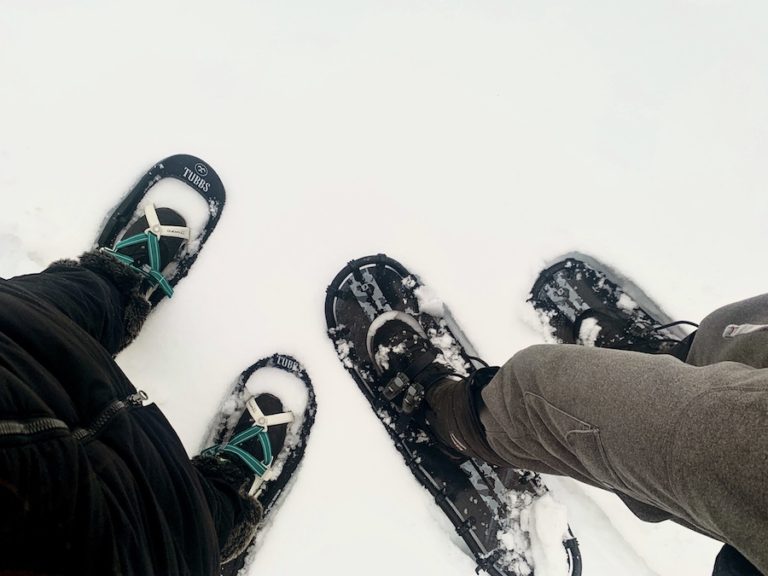Are Trekking Poles Worth Using? (Pros, Cons, Types, & Tips)
If you enjoy hiking, walking or just spending time outdoors, you may be considering the benefits of using trekking poles. However, whether or not to use them depends on your personal needs and preferences. While they are not essential for hiking, it is important to weigh the advantages and disadvantages to determine if they are worth using.
Are Trekking Poles Worth Using? Trekking poles have numerous benefits for all aged hikers at any experience level. Using poles while hiking can help reduce the impact on your hips, knees, and ankles. This helps you hike for longer durations without expending as much energy or being in as much pain. Nonetheless, there are a few things to consider before buying trekking poles.
This article will discuss the advantages and disadvantages of using trekking poles, the different types, materials, grips, and tips for using trekking poles.
Trekking Poles vs Walking Stick
If you are considering investing in trekking poles, a primary question that arises is whether you should purchase a single pole or a pair. To make an informed decision, it is crucial to understand the distinction between poles that are sold as a pair and those sold individually. Generally, there are two categories — trekking poles and walking sticks.
Trekking poles (also known as hiking poles) are sold in pairs and are arguably the most popular option for hikers, snowshoers and backpackers. They help to provide symmetrical stability while also reducing the pressure on your joints. When it comes to hiking, we prefer using trekking poles to provide support in steep and muddy conditions. However, many people feel that just one walking stick provides enough support.
A walking stick, also known as a hiking staff, is a single item sold separately that provides extra stability while hiking or walking. It is an excellent option for hikers who need additional support while taking up minimal space in their pack. For example, the Leki Super Micro Walking Stick is a high-quality collapsible walking stick that is reliable and durable, making it ideal for use on the go.
Choosing the right type of pole depends on your personal preferences and needs. For longer and more challenging hikes, trekking poles could be a good fit as they offer additional support and stability. However, you can also use a walking stick instead of trekking poles for any hike. Ultimately, it comes down to what works best for you and the terrain you’ll be hiking on.
Advantages Of Trekking Poles
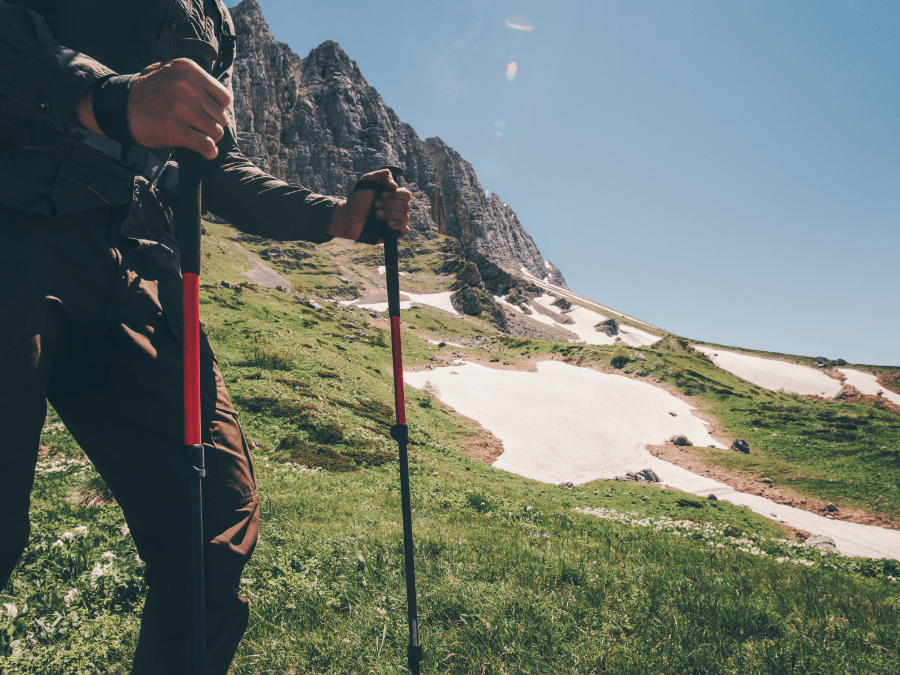
Increase Stability
Trekking poles can provide hikers with numerous benefits, including improved balance and stability on the trails. This is especially helpful when navigating downhill or uneven terrain. By providing additional contact points with the ground, trekking poles can assist in pushing and pulling hikers to the next step, making the journey easier and more efficient.
Reduce Impact
If you’re looking to reduce the impact on your hips, knees, ankles, and other joints while hiking, hiking poles are an excellent option. They work especially well for downhill hikes, allowing you to hike comfortably for longer periods. Some poles even come with shock absorbers built-in for added impact reduction.
Increase Speed
Hiking poles are incredibly useful for hikers to establish a steady walking rhythm, thereby increasing their speed and endurance over time, regardless of the terrain. In addition, trekking poles provide stability and balance, which can be especially helpful on challenging hikes with rugged terrain, allowing hikers to move through difficult sections more easily and quickly.
Redistribute Weight Load
Trekking poles have the added benefit of redistributing weight between your body and backpack, which helps maintain proper posture. As a result, the weight on your upper and lower back is decreased, and it also supports the strengthening of upper back muscles.
Multi-Purpose Use
Poles are not just helpful for making hiking easier, but they can be used in multiple ways throughout your trek. Firstly, they make for a great way to test the terrain before taking a step. This comes in handy when hiking through overly wet terrains to help gauge the depth of puddles or mud. Secondly, they can be used as tent poles to hold down your tent on overnight and multi-day hikes.
Disadvantages Of Trekking Poles
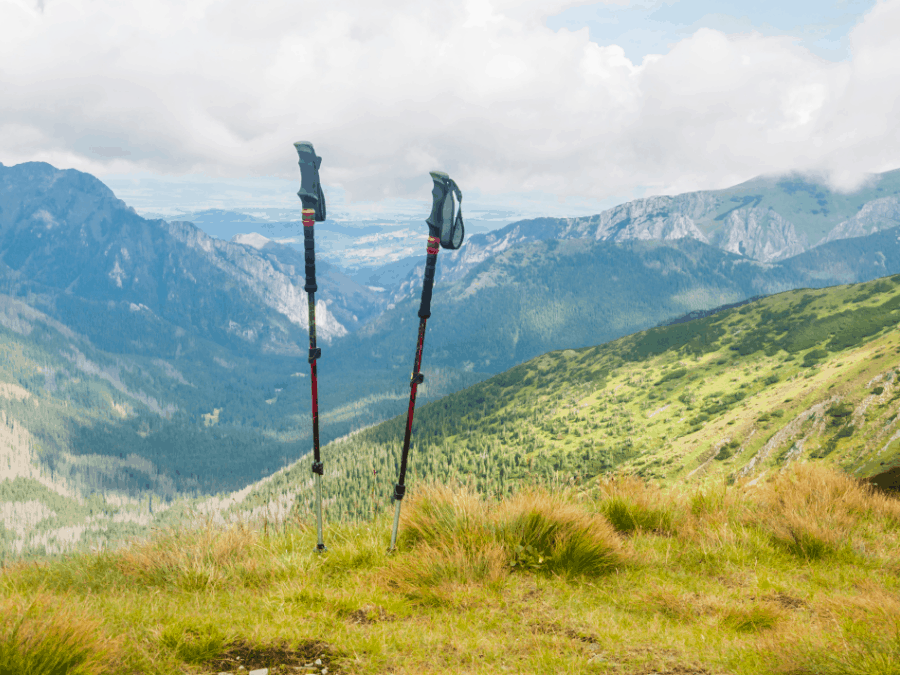
The Cost
If you’re planning to try out trekking poles, it’s important to note that not all poles come with an affordable price tag. While some may see hiking poles as an unnecessary part of hiking gear, they can prove to be quite useful and even prevent injuries. However, it can be difficult to justify spending extra money on them. The Cascade Trekking Poles are a great option for those on a budget. These poles, which we personally use, are priced between $40 and $60, making them an affordable and durable option for any hiker.
They Can Be Limiting
When hiking on certain trails, it may be necessary to use your hands for activities like climbing over obstacles, scrambling or climbing with a rope. In such cases, carrying trekking poles can be inconvenient as you will have to put them away before engaging in these hands-on activities. Furthermore, it is beneficial to keep your hands free and available in case of a fall or encounter with wildlife where you may need to grab your bear spray.
Add Weight
Let’s face it. If you plan on doing a long hike or an overnight hike, chances are you want to pack as light as possible. Planning what you will pack is essential as you want to make sure you are only packing essentials to limit any unnecessary weight. For example, while hiking poles can help reduce your pack’s weight, if you never use them during your hike, they will simply take up space and add extra weight.
Increase Arm Motion
Increased arm motion can be beneficial in engaging your whole body during a hike, but it can also result in the expenditure of additional energy. For light hiking, this may not be an issue. However, if you are undertaking a challenging trek, you may want to conserve energy and avoid expending any additional effort unnecessarily.
Catch On Terrain
When you go hiking with poles, they may get caught on the terrain, causing you to stop frequently to adjust them. This is a common occurrence when bushwalking through thick terrain or in deep mud. Although it may not be a major issue, it is worth taking note of.
Types Of Trekking Poles
If you’re considering trekking poles, it’s important to understand the different types of poles available to help you find the perfect match. Apart from the various pole styles, there are also different materials and grip options to consider.
First is to decide if you want telescoping, fixed or folding trekking poles.
Telescoping Poles
Telescoping trekking poles are the most popular type of poles for trails. They are easily adjustable to various heights, compact for easy storage, and relatively lightweight. These poles typically consist of two to three sections that can be extended with locking mechanisms. Telescoping poles are usually more durable than folding poles and can fit into suitcases, making them perfect for those who enjoy hiking abroad.
A great pair of telescoping poles are the Black Diamond Trail Back Trekking Poles. These poles can adjust between 25″ to 55″ in length, making them suitable for various heights (perfect for the entire family). They feature nonslip EVA foam grips and have an adjustable 3-section shaft.
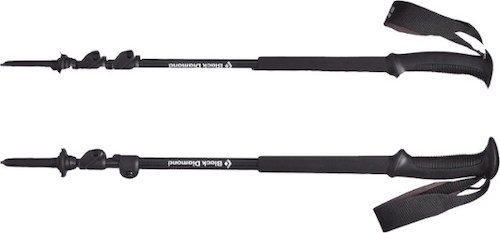
Fixed Poles
Fixed poles are designed to have a fixed length and do not collapse. They have a simple design, which makes them less likely to break since they have fewer parts. Although they are less popular than telescoping and folding poles, some people still choose fixed poles for a few reasons. For instance, they can be more affordable and lightweight than other poles. However, fixed poles can be challenging to store and pack away when not in use, which is why they are not too common on the trails.
An example of fixed poles is the Black Diamond Helio Fixed Length Carbon Ski Poles. Although it is commonly used for skiers, you can also use these poles for mountaineering and hiking. Since they are not adjustable, these poles are incredibly rigid and lightweight.

Folding Poles
If you are a fast hiker or want lightweight and easy-to-pack poles, folding trekking poles are perfect for you. These poles work in a similar style as tent poles and are not adjustable like telescoping poles. Instead, three sections are connected by shock cords. Once collapsed, folding poles are generally smaller than telescoping poles. However, when you assemble them, they become a fixed length. Therefore, it is essential to check which size is suitable for your height before buying a pair of folding trekking poles.
An example of folding trekking poles is the Black Diamond Distance Z Trekking Poles. These poles are lightweight and feature a quick assembly with their one-pull deployment. When collapsed, they are 1/3 their full size, making these poles an outstanding option for travellers.

Types Of Shaft Materials
Once you have decided which style of trekking pole is best suited for you, next comes the material. The material of the pole shaft plays a large role in the overall weight of your trekking poles. There are two main types of materials used for the pole shaft: Carbon and Aluminum.
Carbon Trekking Poles
Carbon trekking poles are perfect for those seeking something more lightweight. They tend to do better at reducing vibration than their aluminum competitor. The downside is that they are not as durable and are also prone to breaking in rougher conditions. Therefore, it is best to use carbon trekking poles on terrains that are not overly rugged to reduce the amount of stress on the poles. In addition, they can come with a higher price tag.
If you are looking for high-quality, lightweight carbon trekking poles, we highly recommend the Black Diamond Alpine Carbon Cork Trekking Poles. These poles feature cork grips and can be used for both hiking and snowshoeing.
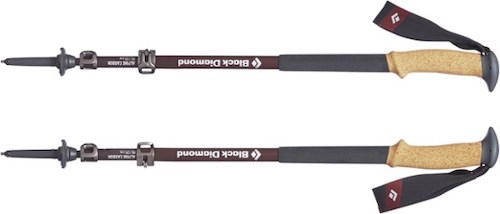
Aluminum Trekking Poles
Aluminum poles are a phenomenal choice for hikers looking for durable and economical trekking poles. Although they tend to be heavier than carbon poles, they are able to handle more stress. It is more likely for aluminum poles to bend than break, making them a good option for rugged trails. Another added benefit is that they are generally less expensive than carbon poles.
The Black Diamond Trail Trekking Poles are a superb example of quality aluminum trekking poles. These poles are comfortable and adjustable. Its sturdy locking mechanisms help when ascending and descending.

Choosing A Grip Type
When it comes to choosing a grip type, it will depend on which feels best in your hands, along with the conditions you plan to hike in. Since they are meant for comfort, picking the right one is necessary. There are three options for grip material types: cork, rubber and foam.
Cork
Out of all the grip types, cork is our favourite. It offers a secure grip and incredible comfort as it moulds to the shape of your hand over time. Cork grips work outstanding for warmer-weather hikes and people with sweaty hands, as cork is a moisture-resistant material. Additionally, cork will not freeze in colder weather, making it suitable for all types of weather conditions.
Rubber
Rubber grips are best suited for people who partake in a lot of winter hiking, snowshoeing and cross-country skiing. These will not freeze in cold weather and also help to insulate your hands. However, while they are considered waterproof, rubber grips are likely to cause chafing and blistering. They are also the least comfortable of the three grip materials. For these reasons, they are not typically recommended.
Foam
Foam grips are highly comfortable and are more durable than cork grips. However, the downside is that foam absorbs water and can fall apart quickly if you tend to hike in wet climates or if you have overly sweaty hands. Similar to rubber, this type of grip can also lead to chafing and blisters when wet.
What Size Trekking Poles Should You Get
Having the right size trekking poles is essential to using them correctly and reaping the benefits. To know if your hiking poles are the right length for you, your arm should be bent at a 90-degree angle when holding the pole straight up and down on flat terrain. Since most hiking poles nowadays can be adjustable in height (except for non-adjustable poles), finding the right height is easier than you may think.
Adjustable Length Trekking Poles
Adjustable length poles are the most popular types of poles as they are generally one-size-fits-all. Many poles can be adjusted between 24 and 55 inches. However, this can vary depending on the brand and make of the poles.
Non-Adjustable Length Trekking Poles
Non-adjustable poles are trekking poles that are fixed in length. Your height determines the length of fixed poles. Almost every brand features a size chart for non-adjustable poles that will help you decide which length best suits your height.
Tips For Using Trekking Poles
Now that we have discussed the different trekking poles, here are a few tips to help you make the most out of your trekking poles.
Using Different Tips
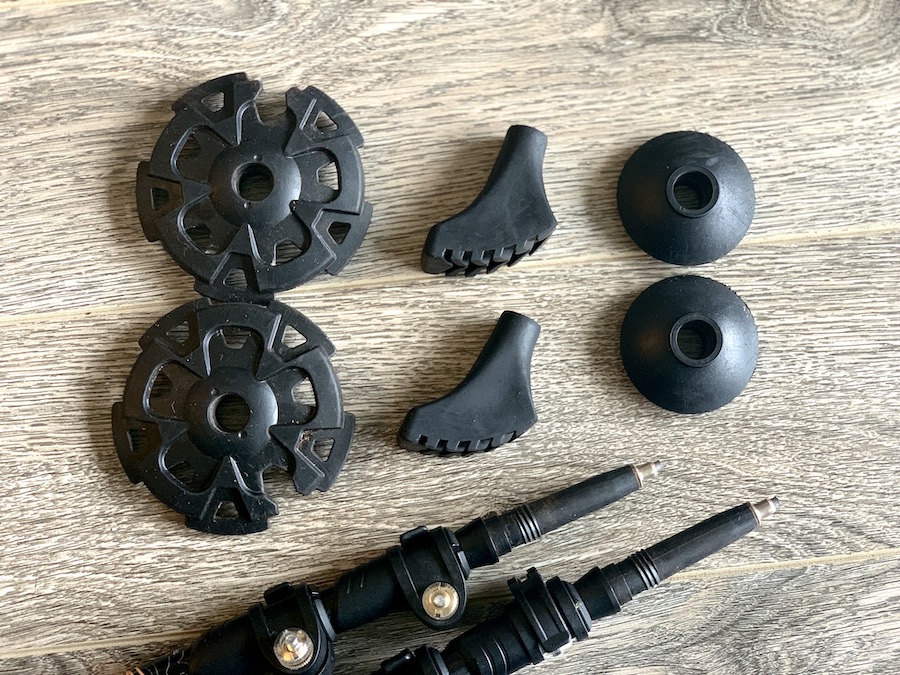
Different types of tips can be attached to your hiking poles to assist with terrains and improve your hiking experience.
- Carbide Tips are the standard tips on trekking poles and can be used on all terrains. However, they tend to work best on dirt and gravel trails. Carbide Tips are durable and have a great grip. The only downside is that they can be quite loud on the trails.
- Boot Feet and Rubber Tips are versatile tips that work well on slippery, paved and gravel terrains. They have impeccable grip and do not cause much damage to the environment. Rubber tips also absorb shock and vibration better than the other tips. A great pair of rubber tips to add to your poles is the Leki Rubber Walking Tips.
- Snow Baskets are used for winter hiking and snowshoeing. These baskets help add flotation and support while in the snow. If you are into winter exploring, we highly recommend getting a pair of snow baskets for your trekking poles.
- Mud Baskets help with mud, sand and other soft terrains. These baskets will prevent you from sinking into the mud, allowing for easier mobility through wet trails.
Overcome Challenging Obstacles
Trekking poles add an extra level of support and stability to help hikers navigate through challenging obstacles easily. Whether you are hiking through rivers and streams, mud, rocky terrain, ascends or descends, poles can be a huge asset to your hiking adventure. If you are planning a long-duration hike or hiking through difficult terrain, investing in hiking poles is a great idea.
Enhance Stability
Poles can aid and enhance your stability while hiking. Hiking poles can be used essentially as additional limbs, helping to keep you upright and balanced. When going uphill or downhill, hikers often use double planting as a way to ground themselves before taking additional steps. To do this, you simply place both poles ahead of you, then walk to meet them and repeat.
Adjusting Pole Lengths
Typically, it is unnecessary to keep adjusting the length of your poles when hiking after setting them to the recommended length for your height. However, adjusting your pole length to better suit obstacles can have some big advantages depending on the terrain.
When going uphill, you can shorten your hiking poles a few inches to avoid overstretching. In contrast, if you are descending, you should lengthen your trekking poles to reduce stress on the knees and avoid bending over your poles. Lastly, if you are hiking alongside a hill or mountain, you should adjust your poles to help keep your balance and add extra support to avoid falling. This requires you to shorten the pole length on the uphill side and lengthen the pole on the “fall side.”
Final Thoughts

Trekking poles are a great asset to your hikes. While not necessary, many hikers reach for trekking poles for all the numerous benefits. Whether you want to reduce pain in your joints, increase your speed, take on longer hikes or keep your arms busy while hiking, trekking poles are worth the investment.


